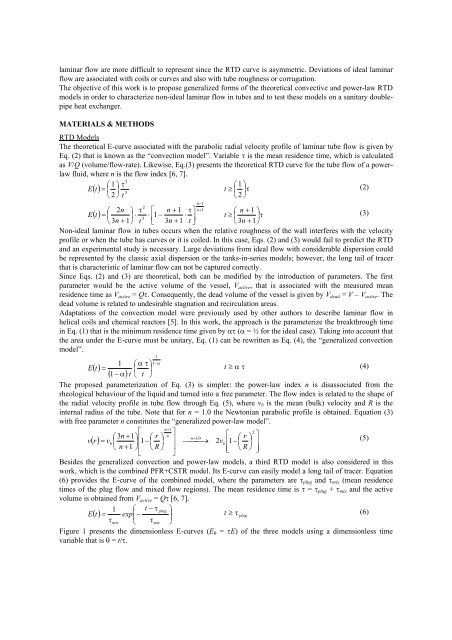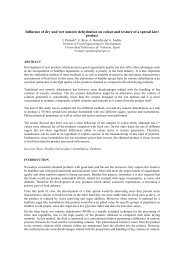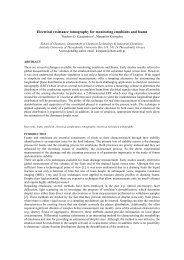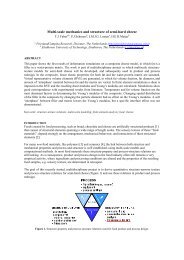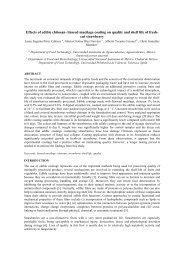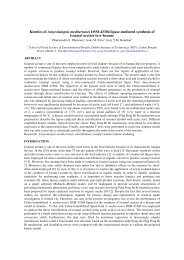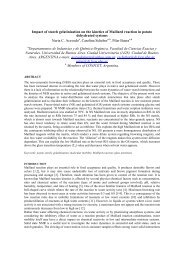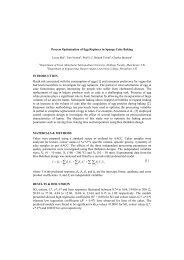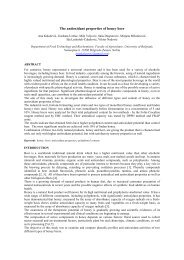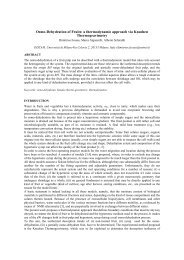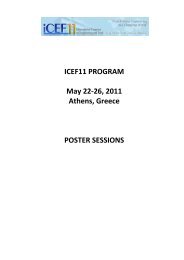Generalized convection and power-law models to represent ... - USP
Generalized convection and power-law models to represent ... - USP
Generalized convection and power-law models to represent ... - USP
You also want an ePaper? Increase the reach of your titles
YUMPU automatically turns print PDFs into web optimized ePapers that Google loves.
laminar flow are more difficult <strong>to</strong> <strong>represent</strong> since the RTD curve is asymmetric. Deviations of ideal laminar<br />
flow are associated with coils or curves <strong>and</strong> also with tube roughness or corrugation.<br />
The objective of this work is <strong>to</strong> propose generalized forms of the theoretical convective <strong>and</strong> <strong>power</strong>-<strong>law</strong> RTD<br />
<strong>models</strong> in order <strong>to</strong> characterize non-ideal laminar flow in tubes <strong>and</strong> <strong>to</strong> test these <strong>models</strong> on a sanitary doublepipe<br />
heat exchanger.<br />
MATERIALS & METHODS<br />
RTD Models<br />
The theoretical E-curve associated with the parabolic radial velocity profile of laminar tube flow is given by<br />
Eq. (2) that is known as the “<strong>convection</strong> model”. Variable is the mean residence time, which is calculated<br />
as V/Q (volume/flow-rate). Likewise, Eq.(3) presents the theoretical RTD curve for the tube flow of a <strong>power</strong><strong>law</strong><br />
fluid, where n is the flow index [6, 7].<br />
2<br />
1 <br />
1 <br />
E t <br />
t <br />
(2)<br />
3<br />
2 t<br />
2 <br />
n1<br />
2n<br />
2<br />
n1<br />
n 1 <br />
n 1 <br />
E t 1<br />
3<br />
3 1 <br />
3 1 t <br />
(3)<br />
n t n t <br />
3n<br />
1<br />
Non-ideal laminar flow in tubes occurs when the relative roughness of the wall interferes with the velocity<br />
profile or when the tube has curves or it is coiled. In this case, Eqs. (2) <strong>and</strong> (3) would fail <strong>to</strong> predict the RTD<br />
<strong>and</strong> an experimental study is necessary. Large deviations from ideal flow with considerable dispersion could<br />
be <strong>represent</strong>ed by the classic axial dispersion or the tanks-in-series <strong>models</strong>; however, the long tail of tracer<br />
that is characteristic of laminar flow can not be captured correctly.<br />
Since Eqs. (2) <strong>and</strong> (3) are theoretical, both can be modified by the introduction of parameters. The first<br />
parameter would be the active volume of the vessel, V active , that is associated with the measured mean<br />
residence time as V active = Q. Consequently, the dead volume of the vessel is given by V dead = V – V active . The<br />
dead volume is related <strong>to</strong> undesirable stagnation <strong>and</strong> recirculation areas.<br />
Adaptations of the <strong>convection</strong> model were previously used by other authors <strong>to</strong> describe laminar flow in<br />
helical coils <strong>and</strong> chemical reac<strong>to</strong>rs [5]. In this work, the approach is the parameterize the breakthrough time<br />
in Eq. (1) that is the minimum residence time given by ( = ½ for the ideal case). Taking in<strong>to</strong> account that<br />
the area under the E-curve must be unitary, Eq. (1) can be rewritten as Eq. (4), the “generalized <strong>convection</strong><br />
model”.<br />
1<br />
1<br />
1 <br />
E t <br />
t <br />
(4)<br />
1<br />
t<br />
t <br />
The proposed parameterization of Eq. (3) is simpler: the <strong>power</strong>-<strong>law</strong> index n is disassociated from the<br />
rheological behaviour of the liquid <strong>and</strong> turned in<strong>to</strong> a free parameter. The flow index is related <strong>to</strong> the shape of<br />
the radial velocity profile in tube flow through Eq. (5), where v b is the mean (bulk) velocity <strong>and</strong> R is the<br />
internal radius of the tube. Note that for n = 1.0 the New<strong>to</strong>nian parabolic profile is obtained. Equation (3)<br />
with free parameter n constitutes the “generalized <strong>power</strong>-<strong>law</strong> model”.<br />
n1<br />
<br />
2<br />
3n<br />
1<br />
<br />
<br />
r n<br />
n1.<br />
0<br />
r<br />
v r v 1<br />
2v<br />
1<br />
<br />
(5)<br />
b<br />
b <br />
n 1<br />
<br />
R <br />
<br />
R <br />
<br />
<br />
Besides the generalized <strong>convection</strong> <strong>and</strong> <strong>power</strong>-<strong>law</strong> <strong>models</strong>, a third RTD model is also considered in this<br />
work, which is the combined PFR+CSTR model. Its E-curve can easily model a long tail of tracer. Equation<br />
(6) provides the E-curve of the combined model, where the parameters are plug <strong>and</strong> mix (mean residence<br />
times of the plug flow <strong>and</strong> mixed flow regions). The mean residence time is = plug + mix <strong>and</strong> the active<br />
volume is obtained from V active = Q [6, 7].<br />
1 t <br />
plug<br />
<br />
<br />
E t exp<br />
<br />
t <br />
(6)<br />
plug<br />
mix<br />
mix<br />
<br />
Figure 1 presents the dimensionless E-curves (E = E) of the three <strong>models</strong> using a dimensionless time<br />
variable that is = t/.


